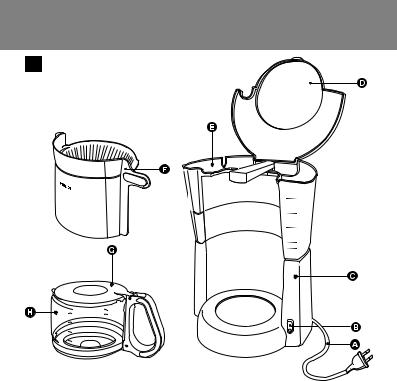PHILIPS HD7448, HD7446 User Manual [vi]

HD7448, HD7446


1

English 6
Español 14
22
Bahasa Melayu 30
TiếngViệt 38
46
53
HD7448, HD7446

English
Introduction
Congratulations on your purchase and welcome to Philips!To fully benefit from the support that Philips offers, register your product at www.philips. com/welcome.
General description (Fig. 1)
ACord with mains plug
BOn/off switch
CCoffeemaker
DLid of coffeemaker
EWater tank
FFilter holder
GLid of jug
HJug
Important
Read this user manual carefully before you use the appliance and save it for future reference.
Danger
-Never immerse the appliance in water or any other liquid.
Warning
-Check if the voltage indicated on the appliance corresponds to the local mains voltage before you connect the appliance.
-Do not use the appliance if the plug, the mains cord or the appliance itself is damaged.
-If the mains cord is damaged, you must have it replaced by Philips, a service centre authorised by Philips or similarly qualified persons in order to avoid a hazard.
-This appliance is not intended for use by persons (including children) with reduced physical, sensory or mental capabilities, or lack of experience and knowledge, unless they have been given supervision or instruction concerning use of the appliance by a person responsible for their safety.

English
-Children should be supervised to ensure that they do not play with the appliance.
-Keep the mains cord out of the reach of children. Do not let the mains cord hang over the edge of the table or worktop on which the appliance stands.
Caution
-Do not place the appliance on a hot surface and do not let the mains cord come into contact with hot surfaces.
-Unplug the appliance before you clean it and if problems occur during brewing.
Electromagnetic fields (EMF)
This Philips appliance complies with all standards regarding electromagnetic fields (EMF). If handled properly and according to the instructions in this user manual, the appliance is safe to use based on scientific evidence available today.
Preparing for use
1Clean the jug and the filter holder (see chapter‘Cleaning’).
2Put the appliance on a flat and stable surface.
3Put the plug in an earthed wall socket.
4To store excess cord,push it into the opening at the back of the coffee maker (Fig.2).
Make sure that the cord does not come into contact with hot surfaces.
Flushing the appliance
1Open the lid (Fig.3).
2Fill the water tank with cold fresh water and put the jug in place (Fig.4).
Do not put a filter and ground coffee in the filter holder.
3Press the on/off switch to switch on the appliance. (Fig.5)
,The power-on light goes on (HD7448 only).

English
Let the appliance run until the water tank is empty.
4 Switch off the appliance when all the water is in the jug.
5Let the appliance cool down for at least 3 minutes before you start to brew coffee.
Using the appliance
Brewing coffee
1 Open the lid (Fig.3).
2 Fill the water tank with fresh cold water (Fig.6).
- The graduations on the left are for large cups (120ml). - The graduations on the right are for small cups (80ml).
3 Close the lid.
4 Place the jug on the hotplate.
Make sure you place the jug properly on the hotplate.
Note: If you do not place the jug properly on the hotplate, the drip
stop prevents the coffee from flowing into the jug and the filter.As a result, the filter may overflow.
5 Open the filter holder (Fig.7).
6Take a paper filter (type 1x4 or no.4) and fold the sealed edges to prevent tearing and folding.
In some countries, this coffee maker comes with a permanent filter. In that case, do not use paper filters.
7 Put the filter in the filter holder.
8 Put pre-ground coffee (filter-fine grind) in the filter (Fig.8).
-For large cups: use one heaped measuring spoon of ground coffee for each cup.
-For small cups: use one level measuring spoon of ground coffee for each cup.
9 Close the lid.

English
10Press the on/off button to switch on the appliance (Fig.5).
,The power-on light goes on (HD7448 only).
11When all the water has passed through the filter,you can remove the jug from the appliance.
12Switch off the appliance after use.
13Let the appliance cool down for at least 3 minutes before you start to brew coffee again.
14Remove the filter holder and throw away the paper filter.
If you have used the permanent filter, empty and rinse it.
Cleaning
Always unplug the appliance before you clean it.
Never immerse the appliance in water.
1Clean the outside of the appliance with a moist cloth.
2Detach the filter holder.
3Clean the jug and the removable filter holder in hot water with some washing-up liquid or in the dishwasher (Fig.9).
4After cleaning,rinse the jug with fresh hot water.
Descaling
Regular descaling prolongs the life of the appliance and guarantees optimal brewing results for a long time.
In case of normal use (two full jugs of coffee every day), descale the coffee maker:
-2 or 3 times a year if you use soft water;
-4 or 5 times a year if you use hard water.
Contact your local water board for information about the water hardness in your area.
1Fill the water tank with white vinegar (4% acetic acid).Do not put a filter and ground coffee in the filter holder.

10 English
You can also use an appropriate liquid descaler. In this case, follow the instructions on the package of the descaler.
Do not use a descaling powder.
2 Let the appliance complete two brewing cycles.
See chapter ‘Using the appliance’. Let the appliance cool down before you start the second brewing cycle.
3Let the appliance complete two more brewing cycles with fresh, cold water to remove all vinegar or descaler residues.
4Clean the separate parts (see chapter‘Cleaning’).
Accessories
-You can order a new jug from your Philips dealer or a Philips service centre under type number HD7983/70 (white) or HD7983/20 (black).
-You can order a permanent filter from your Philips dealer or a Philips service centre under reference number 4822 48050 479 (permanent nylon coffee filter).
Environment
-Do not throw away the appliance with the normal household waste at the end of its life, but hand it in at an official collection point for recycling. By doing this, you help to preserve the
environment (Fig. 10).
Guarantee & service
If you need service or information or if you have a problem, please visit the Philips website at www.philips.com or contact the Philips Consumer
Care Centre in your country (you find its phone number in the worldwide guarantee leaflet). If there is no Consumer Care Centre in your country, go to your local Philips dealer.

English 11
Troubleshooting
If problems arise with your coffee maker and you cannot solve them with
Problem Solution
The appliance does not Make sure that: work.
-the appliance is plugged in.
-the voltage indicated on the appliance corresponds to the local mains voltage.
-the appliance is switched on.
In all other cases, contact the Philips Consumer Care Centre.
Water leaks out of the Make sure that: appliance.
- the water tank has not been filled beyond the MAX level.
In all other cases, contact the Philips Consumer Care Centre.
The appliance takes a Descale the appliance (see chapter long time to brew ‘Descaling’).
coffee.
The appliance produces Make sure that: a lot of noise and
steam during the brewing process.
- the water tank is filled with COLD water.

12 English
Problem |
Solution |
|
- the appliance is not blocked by scale. If |
|
necessary, descale the appliance (see chapter |
|
‘Descaling’). |
Coffee grounds end up |
Make sure that: |
in the jug. |
|
|
- the filter holder has not overflowed |
|
because there is too much ground coffee in |
|
the filter. |
|
- the filter holder has not overflowed |
|
because the jug has not been placed |
|
correctly under the filter holder. |
|
- the opening in the bottom of the filter |
|
holder is not clogged. |
|
- you use the right size of paper filter. |
|
- the paper filter is not torn. |
The coffee is too weak. |
Make sure that: |
|
- you use the right proportion of coffee to |
|
water. |
|
- the paper filter has not collapsed. |
|
- you use the right size of paper filter. |
The coffee does not |
Do not leave the jug with coffee on the |
taste good. |
hotplate too long, especially not if it only |
|
contains a small amount of coffee. |
The coffee is not hot |
Make sure that: |
enough. |
|
|
- you place the jug properly on the hotplate. |

English 13
Problem Solution
There is less coffee in the jug than expected.
- the hotplate and the jug are clean (see chapter ‘Cleaning’).
We advise you to brew more than three cups of coffee to ensure that the coffee has the right temperature.
Tips:
-use thin cups, because they absorb less heat from the coffee than thick cups.
-do not use cold milk straight from the refrigerator.
Make sure you place the jug properly on the hotplate. If the jug is not placed properly on the hotplate, the drip stop prevents the coffee from flowing out of the filter.

14 Español
Introducción
Enhorabuena por la compra de este producto y bienvenido a Philips. Para sacar el mayor partido de la asistencia que Philips le ofrece, registre su producto en www.philips.com/welcome.
Descripción general (fig.1)
ACable de alimentación con clavija
BInterruptor de encendido/apagado
CCafetera
DTapa de la cafetera
EDepósito de agua
FPortafiltro
GTapa de la jarra
HJarra
Importante
Antes de usar el aparato, lea atentamente este manual de usuario y consérvelo por si necesitara consultarlo en el futuro.
Peligro
-No sumerja nunca el aparato en agua u otros líquidos.
Advertencia
-Antes de enchufar el aparato, compruebe si el voltaje indicado en el mismo se corresponde con el voltaje de red local.
-No utilice el aparato si la clavija, el cable de alimentación o el propio aparato están dañados.
-Si el cable de alimentación está dañado, debe ser sustituido por
Philips o por un centro de servicio autorizado por Philips, con el fin de evitar situaciones de peligro.
-Este aparato no debe ser usado por personas (adultos o niños) con su capacidad física, psíquica o sensorial reducida, ni por quienes no tengan los conocimientos y la experiencia necesarios, a menos que sean supervisados o instruidos acerca del uso del aparato por una persona responsable de su seguridad.
-Asegúrese de que los niños no jueguen con este aparato.

Español 15
-Mantenga el cable de alimentación fuera del alcance de los niños. No deje que el cable de alimentación cuelgue del borde de la mesa o encimera donde esté colocado el aparato.
Precaución
-No coloque el aparato en una superficie caliente y asegúrese de que el cable de alimentación no entra en contacto con superficies calientes.
-Desenchufe el aparato antes de limpiarlo y si surgen problemas durante su uso.
Campos electromagnéticos (CEM)
Este aparato Philips cumple todos los estándares sobre campos electromagnéticos (CEM). Si se utiliza correctamente y de acuerdo con las instrucciones de este manual, el aparato se puede usar de forma segura según los conocimientos científicos disponibles hoy en día.
Preparación para su uso
1Limpie la jarra y el portafiltro (consulte el capítulo“Limpieza”).
2Coloque el aparato sobre una superficie plana y estable.
3Conecte el aparato a un enchufe con toma de tierra.
4Para guardar el cable sobrante,colóquelo en la apertura que se encuentra en la parte posterior de la cafetera (fig.2).
Asegúrese de que el cable no entra en contacto con superficies calientes.
Limpieza del aparato antes de usarlo
1Abra la tapa (fig.3)
2Llene el depósito de agua con agua fría y coloque la jarra en su sitio (fig.4).
No ponga un filtro ni café molido en el portafiltro.
3Pulse el interruptor de encendido/apagado para encender el aparato. (fig.5)

16 Español
,El piloto de encendido se ilumina (sólo modelo HD7448).
Deje que el aparato funcione hasta que el depósito del agua se vacíe por completo.
4 Apague el aparato cuando toda el agua esté en la jarra.
5Deje que el aparato se enfríe durante al menos 3 minutos antes de preparar café.
Uso del aparato
Cómo hacer café
1 Abra la tapa (fig.3)
2 Llene el depósito de agua con agua fría (fig.6).
- Las graduaciones de la izquierda corresponden a tazas grandes (120 ml).
- Las graduaciones de la derecha corresponden a tazas pequeñas (80 ml).
3 Cierre la tapa.
4 Coloque la jarra sobre la placa caliente.
Asegúrese de que la jarra está bien colocada en la placa caliente.
Nota: Si no coloca la jarra correctamente sobre la placa caliente, el antigoteo impedirá que el café caiga en la jarra y el filtro.De este modo,el filtro podrá rebosar.
5 Abra el portafiltro (fig.7).
6Coja un filtro de papel (de tipo 1 x 4 o nº 4) y doble los bordes sellados para evitar que se rompa o arrugue.
En algunos países esta cafetera viene con un filtro permanente. En ese caso, no utilice filtros de papel.
7 Coloque el filtro en el portafiltro.
8 Ponga café molido (molido fino para filtro) en el filtro (fig.8).
-Para tazas grandes: utilice un cacito dosificador colmado de café molido por taza.

Español 17
-Para tazas pequeñas: utilice un cacito dosificador raso de café molido por taza.
9 Cierre la tapa.
10Pulse el botón de encendido/apagado para encender el aparato (fig.5).
,El piloto de encendido se ilumina (sólo modelo HD7448).
11Cuando toda el agua haya pasado por el filtro,puede retirar la jarra del aparato.
12Apague el aparato después de usarlo.
13Deje que el aparato se enfríe durante al menos 3 minutos antes de preparar café de nuevo.
14Quite el soporte del filtro y tire el filtro de papel.
Si ha utilizado un filtro permanente, vacíelo y enjuáguelo.
Limpieza
Desenchufe siempre el aparato antes de limpiarlo.
No sumerja nunca el aparato en agua.
1Limpie el aparato por fuera con un paño húmedo.
2Desmonte el portafiltro.
3Lave la jarra y el portafiltro extraíble con agua caliente y un poco de detergente o en el lavavajillas (fig.9).
4Después de lavarla,aclare la jarra con agua caliente.
Eliminación de los depósitos de cal
Si elimina los depósitos de cal con regularidad, prolongará la vida del aparato y garantizará resultados óptimos durante mucho tiempo.
En caso de un uso normal (dos jarras llenas de café al día), elimine los depósitos de cal de la cafetera:
-2 ó 3 veces al año si utiliza agua blanda;
-4 ó 5 veces al año si utiliza agua dura;

18 Español
Consulte a la compañía suministradora de agua para obtener información acerca de la dureza del agua en su zona.
1Llene el depósito de agua con vinagre blanco (4% de ácido acético). No ponga ni filtro ni café molido en el soporte del filtro.
También puede utilizar un agente desincrustante líquido adecuado. En ese caso, siga las instrucciones indicadas en el embalaje del desincrustante.
No utilice agentes desincrustantes en polvo.
2Deje que el aparato complete dos ciclos de preparación de café.
Consulte el capítulo “Uso del aparato”. Deje que el aparato se enfríe antes de empezar el segundo ciclo.
3Deje que el aparato complete otros dos ciclos con agua fría limpia para eliminar todos los restos de vinagre o de cal.
4Limpie todas las piezas (consulte el capítulo“Limpieza”).
Accesorios
-Puede solicitar una jarra adicional a su distribuidor Philips o a un centro de servicio Philips; el número de modelo es HD7983/70 (en blanco) o HD7983/20 (en negro).
-Puede solicitar un filtro permanente a su distribuidor Philips o un centro de servicio Philips; el número de referencia es 4822 48050 479 (filtro de café permanente de nylon).
Medio ambiente
-Al final de su vida útil, no tire el aparato junto con la basura normal del hogar. Llévelo a un punto de recogida oficial para su reciclado. De esta manera ayudará a conservar el medio ambiente (fig. 10).
Garantía y servicio
Si necesita información o si tiene algún problema, visite la páginaWeb de
Philips en www.philips.com, o póngase en contacto con el Servicio de
Atención al Cliente de Philips en su país (hallará el número de teléfono

Español 19
en el folleto de la garantía mundial). Si no hay Servicio de Atención al
Cliente de Philips en su país, diríjase a su distribuidor local Philips.
Guía de resolución de problemas
Si surge algún problema con la cafetera y no puede solucionarlo con la siguiente información, póngase en contacto con el centro de servicio
Problema |
Solución |
El aparato no |
Asegúrese de que: |
funciona. |
|
|
- el aparato está enchufado. |
|
- el voltaje indicado en el aparato se |
|
corresponde con el voltaje de red local. |
|
- el aparato está encendido. |
|
En todos los demás casos, póngase en contacto |
|
con el Centro de Atención al Cliente de Philips. |
El aparato gotea. |
Asegúrese de que: |
El aparato tarda mucho tiempo en preparar el café.
- el depósito de agua no se ha llenado por encima de la indicación MAX.
En todos los demás casos, póngase en contacto con el Centro de Atención al Cliente de Philips.
Elimine los depósitos de cal del aparato (consulte el capítulo“Eliminación de depósitos de cal”).

20 Español
Problema |
Solución |
El aparato hace |
Asegúrese de que: |
mucho ruido y sale |
|
mucho vapor |
|
durante el proceso |
|
de preparación del |
|
café. |
|
|
- el depósito de agua se ha llenado con agua |
|
FRÍA. |
|
- el aparato no esté bloqueado por restos de |
|
cal. Si es necesario, elimine la cal del aparato |
|
(consulte el capítulo“Eliminación de los |
|
depósitos de cal”). |
Hay posos de café |
Asegúrese de que: |
en la jarra. |
|
|
- el soporte del filtro no ha rebosado debido a |
|
un exceso de café molido en el filtro. |
|
- el soporte del filtro no ha rebosado debido a |
|
que la jarra no estaba correctamente colocada |
|
debajo del soporte del filtro. |
|
- la abertura de la parte inferior del soporte |
|
del filtro no está obstruida. |
|
- el papel de filtro que utiliza es del tamaño |
|
apropiado. |
|
- el filtro de papel no está roto. |
El café es demasiado |
Asegúrese de que: |
flojo. |
|
|
- utiliza las proporciones adecuadas de café y |
|
agua. |
|
- el filtro del papel no se ha ido hacia abajo. |
